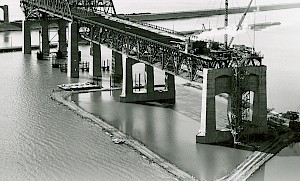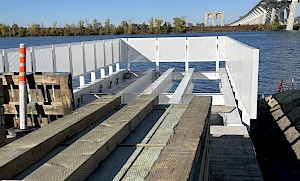- © 2025 The Jacques Cartier and Champlain Bridges Incorporated
- Terms of Use
- Site Map
Quebec City, Quebec, November 12, 2024 — The Honourable Jean-Yves Duclos, Minister of Public Services and Procurement and Quebec Lieutenant, announced today that the conditions necessary for the repatriation of the Québec Bridge to the federal government have been met. As a result, the Government of Canada is once again the owner of this historic infrastructure, essential to the economy of Canada and Quebec.
The Government of Canada announced in May that it had reached an agreement in principle with Canadian National Railway (CN) to transfer ownership of the Québec Bridge. The agreement was formalized by the signing of a deed of transfer between Canada and CN on November 12, 2024.
The retrocession of the Québec Bridge will enable the Government of Canada to ensure the sustainability of this strategic infrastructure so that it can continue to benefit the economies of Canada and Quebec, as well as the entire population of the greater Quebec City region.
Management of the Québec Bridge will be entrusted to the federal Crown corporation Jacques Cartier and Champlain Bridges Incorporated (JCCBI), which will assume all responsibilities as owner of the infrastructure, and will be responsible for implementing the rehabilitation plan for the Québec Bridge. The Government of Canada is confident that the expertise and experience acquired by JCCBI over the years, notably in operating the Jacques Cartier and Honoré Mercier bridges in Montreal, will enable it to successfully carry out this rehabilitation plan.
JCCBI will work closely with the two other partners and users of the Québec Bridge, CN, which remains responsible for the rail corridor, and the Quebec government, which remains responsible for the road corridor and bicycle path. A collaboration agreement between these three partners will be drawn up to optimize coordination and ensure the completion of all activities on the Québec Bridge.
The Government of Canada will invest more than $40 million a year over a 25-year period in the rehabilitation program. This program will begin with inspections and various studies to make the right diagnoses, prepare a detailed rehabilitation plan and prioritize the work to be carried out. The work will include repair and reinforcement of the steel, piers and footings, as well as a painting program to protect the steel from corrosion and improve the overall appearance of the bridge structure.
To support JCCBI, the Government of Canada has also announced the creation of an advisory committee: the Groupe consultatif pour la sauvegarde du pont de Québec. In the coming weeks, JCCBI will be responsible for setting up this advisory group.
This committee, made up of business people, experts and other citizens interested in the future of the Québec Bridge, will serve as a platform for expressing opinions and formulating proposals to JCCBI. Further details on the submission and selection process will follow.
The Québec Bridge is of great economic, strategic and heritage importance. For over 100 years, the people of the region have relied on this bridge for their daily commutes, tourism and trade. The Government of Canada recognizes the importance of this bridge as a strategic freight corridor for regional, national and international markets, and as an important link in the Canadian supply chain.
The Government of Canada also wishes to remember the tragic history of the bridge’s construction and the legacy of the many workers who lost their lives in its construction. It also recognizes that this bridge crosses the ancestral territory of several First Nations who have occupied this site since time immemorial.
“One more step has been taken to protect and ensure the long-term viability of the Québec Bridge. I am very proud to announce today that the federal government has officially gained ownership of this architectural and heritage jewel in Quebec City. Over the next 25 years, our government is committed to investing more than $40 million annually to ensure the sustainability of this essential and historic infrastructure, for the greater benefit of Canada’s economy and Quebec’s.”
The Honourable Sean Fraser, Minister of Housing, Infrastructure and Communities
“The Québec Bridge is a critical and major infrastructure for the Quebec City region. By repatriating this essential link, we are ensuring that the bridge can continue to benefit not only our country’s economy, but also the users and residents of the greater Quebec City region who have been using this bridge for their daily commute for over a century. Today, we’re giving the Bridge back to Quebecers!”
The Honourable Jean-Yves Duclos, Minister of Public Services and Procurement and Quebec Lieutenant
“The Québec Bridge is more than just a bridge. It’s also a symbol of pride for the people of Quebec City. Repatriating the Québec Bridge to the federal government will ensure the longevity of this infrastructure and preserve its historical, cultural and economic value for future generations.”
Joël Lightbound, Member of Parliament for Louis-Hébert
“We are delighted with today’s announcement, and would like to thank the Government of Canada for its confidence in our organization. Our team is excited to begin this new mandate to maintain this iconic structure. At the same time, we know how important this structure is to the population of the greater Quebec City area and all of Quebec, and we are committed to restoring the beauty of this great structure while extending its lifespan.”
Sandra Martel, Chief Executive Officer for Jacques Cartier and Champlain Bridges Incorporated


